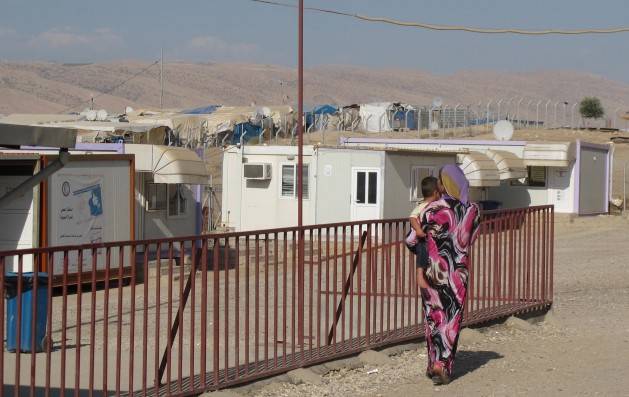What these poor women have to go through!!!
Geographical Divide in Maternal Health for Syrian Refugees
By Shelly KittlesonReprint | | Print | Send by email |En español
Print | Send by email |En español

A young mother approaches a healthcare facility inside the Domiz refugee camp in Iraqi Kurdistan, mid-September 2014. Credit: Shelly Kittleson/IPS
DOHUK, Iraq, Sep 19 2014 (IPS) - At the largest refugee camp in Iraqi Kurdistan, young Syrian mothers and pregnant women are considered relatively lucky.
The number of registered Syrian refugees surpassed 3 million in late August, with the highest concentrations in Lebanon (over 1.1 million), Turkey (over 800,000), and Jordan (over 600,000). In all of the above, serious concerns have been expressed about the availability of healthcare services for expectant mothers.
In Lebanon, for example – which hosts the largest number of Syrian refugees, 76 percent of whom are women and children – the U.N. refugee agency (UNHCR) last year had to reduce its coverage of delivery costs for mothers to 75 percent instead of 100 percent, due to funding shortfalls.
Though some in the Domiz camp live in tents on the edges of the camp with little access to basic sanitation facilities, others reside in small container-like facilities interspersed with wedding apparel shops and small groceries, and enjoy the right to public healthcare
The Domiz camp in the northern Dohuk province houses over 100,000 mostly Syrian Kurds, but is in a geographical area with a 189 percent coverage rate of humanitarian aid funding requests in 2014. The Syria Humanitarian Response Plan (SHARP) has received only 33 percent of the same.
Continue reading at:
Geographical Divide in Maternal Health for Syrian Refugees Inter Press Service?
Geographical Divide in Maternal Health for Syrian Refugees
By Shelly KittlesonReprint | |
 Print | Send by email |En español
Print | Send by email |En español
A young mother approaches a healthcare facility inside the Domiz refugee camp in Iraqi Kurdistan, mid-September 2014. Credit: Shelly Kittleson/IPS
DOHUK, Iraq, Sep 19 2014 (IPS) - At the largest refugee camp in Iraqi Kurdistan, young Syrian mothers and pregnant women are considered relatively lucky.
The number of registered Syrian refugees surpassed 3 million in late August, with the highest concentrations in Lebanon (over 1.1 million), Turkey (over 800,000), and Jordan (over 600,000). In all of the above, serious concerns have been expressed about the availability of healthcare services for expectant mothers.
In Lebanon, for example – which hosts the largest number of Syrian refugees, 76 percent of whom are women and children – the U.N. refugee agency (UNHCR) last year had to reduce its coverage of delivery costs for mothers to 75 percent instead of 100 percent, due to funding shortfalls.
Though some in the Domiz camp live in tents on the edges of the camp with little access to basic sanitation facilities, others reside in small container-like facilities interspersed with wedding apparel shops and small groceries, and enjoy the right to public healthcare
The Domiz camp in the northern Dohuk province houses over 100,000 mostly Syrian Kurds, but is in a geographical area with a 189 percent coverage rate of humanitarian aid funding requests in 2014. The Syria Humanitarian Response Plan (SHARP) has received only 33 percent of the same.
Continue reading at:
Geographical Divide in Maternal Health for Syrian Refugees Inter Press Service?
